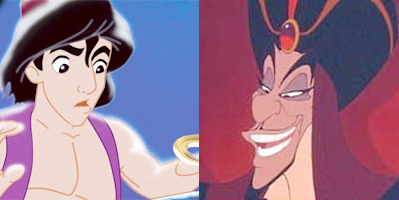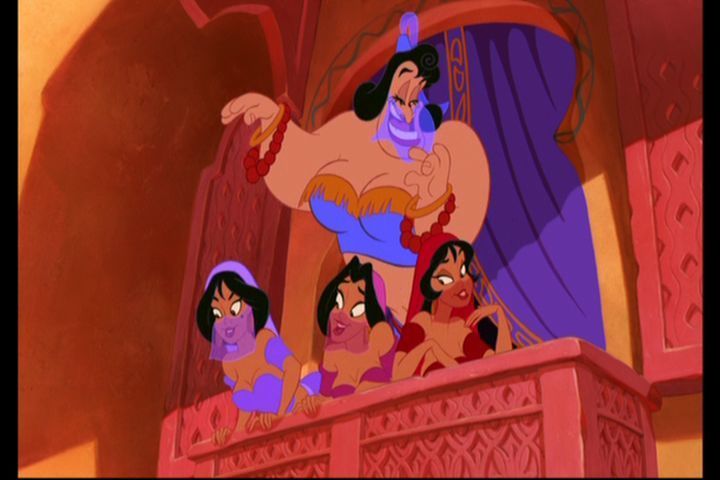 "You mean everyone who is Arabian can't breath fire or charm snakes?" is the question many parents might get from their children after watching the Disney movie "Aladdin". The first time children usually see this movie is at a young age, when their mind is most impressionable. If they haven't had exposure to Arabs, this movie becomes their definition of what an Arab is. The cultivation theory is prevalent in children who have watched "Aladdin". They automatically assume whatever happens in the movie must be how Arabs truly are. That would be fine if the movie spoke truly of Arabs and didn't focus on their stereotypes. Sadly Disney pulls out every stereotype in the book. Children will take these stereotypes and create a schema of Arabs. The schema theory will be very prevalent for children watching "Aladdin" because most haven't had experience with the Arabian culture at such a young age.
"You mean everyone who is Arabian can't breath fire or charm snakes?" is the question many parents might get from their children after watching the Disney movie "Aladdin". The first time children usually see this movie is at a young age, when their mind is most impressionable. If they haven't had exposure to Arabs, this movie becomes their definition of what an Arab is. The cultivation theory is prevalent in children who have watched "Aladdin". They automatically assume whatever happens in the movie must be how Arabs truly are. That would be fine if the movie spoke truly of Arabs and didn't focus on their stereotypes. Sadly Disney pulls out every stereotype in the book. Children will take these stereotypes and create a schema of Arabs. The schema theory will be very prevalent for children watching "Aladdin" because most haven't had experience with the Arabian culture at such a young age.It was so interesting to re-watch this movie and pick up on so many things that I didn't notice when I was younger. For example, characters in the movie who are the "bad guys" have an exaggerated Arabian accent. The characters deemed the "good guys" have an American accent. It's also interesting that the bad characters have a darker complexion than the good characters do. The movie hits on all the stereotypes that are given to Arabs; all they do is ride camels, watch scantily clad women dance and wear turbans. The movie also touches on the "barbaric" nature of Arabs. It shows how the punishment for stealing is to cut the theif's hand off and even starts the movie by labeling the town as barbaric. While the movie will show a woman's hand almost get cut off, it won't let the act be mentioned in its songs. In the original opening of the movie, the song included the lyrics "Where they cut off your ear if they don't like your face". Disney had to change the words due to complaints from offended viewers. The video below plays the original lyrics to the song.
 The movie deems the Middle East as a place that should be avoided. The opening song calls the city barbaric and the name of the city, Aghrabah, in English means "very strange". I also found that the movie heavily portrays the stereotype of eroticized women, with dancing women in very little clothes in many of the scenes. The women are seen as oppressed, seen but not heard. This actually isn't true anymore. Women are allowed to vote and even hold jobs. This movie sets a wrong image of the Arabs and sadly children are learning this image through cultivation theory. Below are charts of all of the stereotypes I found of Arabs throughout the movie "Aladdin".
The movie deems the Middle East as a place that should be avoided. The opening song calls the city barbaric and the name of the city, Aghrabah, in English means "very strange". I also found that the movie heavily portrays the stereotype of eroticized women, with dancing women in very little clothes in many of the scenes. The women are seen as oppressed, seen but not heard. This actually isn't true anymore. Women are allowed to vote and even hold jobs. This movie sets a wrong image of the Arabs and sadly children are learning this image through cultivation theory. Below are charts of all of the stereotypes I found of Arabs throughout the movie "Aladdin".Eroticized Women | Barbaric | Swarthy | Villain | Ignorant |
Aladdin runs into a house with that has many scantily clad women dancing around and one larger woman that seems to be in charge of the house. | The beginning song of the movie describes Aladdin’s homeland as “It’s barbaric, but hey it’s home” | Characters who are evil in the movie have a darker complexion than those who are seen as good characters. | Jafar’s main mission is become Sultan and obtain riches. He will do anything, regardless of it’s bad nature, to achieve this (manipulates the Sultan, uses Aladdin for the lamp, lies and steals). | One of the poor people was ignorant enough to risk his life to find a lamp for Jafar. |
Jasmine always wears a shirt that shows her stomach. | As punishment for stealing, a street merchant tries to cut off Jasmine’s hand. | Those who are deemed evil have exaggerated accents while characters deemed good have American accents. Those with exaggerated accents are Jafar, a prisoner, a thief, the palace guards ,merchants, and the rude suitor for the princess. | The suitor for the princess feels he is greater than the townspeople and can therefore treat them however he wishes. | The Sultan lets his advisor, Jafar, walk all over him. Jafar eventually becomes Sultan because of this. |
Jafar puts Jasmine in even less clothing and shackles when he becomes Sultan. | Sultan is “always playing with his toys” instead of running his land. | |||
When Genie comes out of the lamp for the first time there are a lot of women in very few clothing dancing. | ||||
The arrival of Prince Ali is adorned with many women dancing in very few clothing. |
Negative Perception of Women | Wealth Oriented | Dehumanization | Generalization |
Arranged marriages are normal and common. | Merchants on the streets would always harass people to buy their goods. They tried to sell their things at any cost. | When the palace guards were at the market place they would call people “street rats” if you aren’t royalty or associated with it you are a street rat. | Men always wear turbans. |
The Sultan is trying to find a man for Jasmine to “take care of her and provide for her” insinuating that she can’t take care of herself or have a job. | All Jafar wanted was the wealth and recognition that came with being a Sultan. | Jafar turns into a snake, showing his true personality of being untrustworthy and a crook. | The only transportation available are camels, horses, or elephants. |
Women are either dancing in very few clothing or doing laundry. | When Prince Ali throws a few coins in the street many people run to retrieve the small amount of coins. | Men in the streets would put swords down their throats, walk on hot coals, lay on beds of nails, are fire breathers, or are snake charmers. | |
Jafar places Jasmine in shackles and then places her in an hourglass- shows no respect for women. | The entire country is empty desert. | ||
Most women who didn’t have a speaking role in the movie had a veil over their lower face. |

The categories of stereotypes that I researched in the movie "Aladdin" are eroticized women, barbaric, villain, swarthy, ignorant, negative perception of women, wealth oriented, dehumanization, and generalization. Most of these categories are self explanatory. The negative perception of women category focuses on the false perception that Arabic women have no rights. The wealth oriented category focuses on the stereotype that Arabs will do anything for a dollar. The movie has multiple instances of merchants in the market place trying to force people to buy their things; if they are denied they are always willing to bargain. The generalization category is silly stereotypes about the everyday life and culture of Arabs that people think are true after watching this movie. These consists of the idea that the only transportation available are camels, the whole country is desert, and all Arabs can lay on a bed of nails or walk on hot stones. The picture to the right shows the awful stereotype that all Arabs are villains or terrorists. From my research, the stereotypes most focused on in the movie are eroticized women, negative perceptions of women, wealth oriented, and generalizations of the Arabs as a whole. It's sad that people cling on to old stereotype or assumptions of a culture that aren't true. Hopefully parents will point out these falsities to their children after they view the movie.

